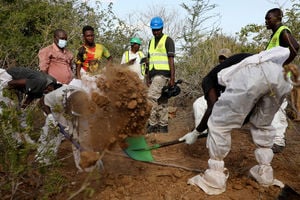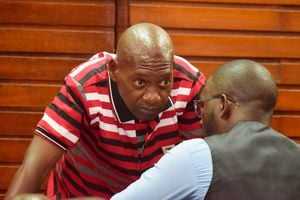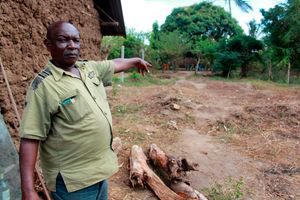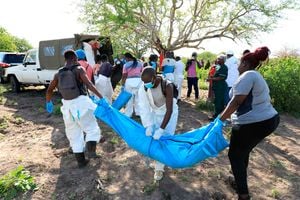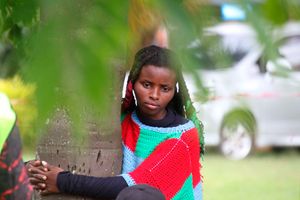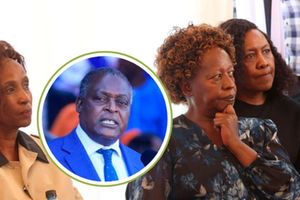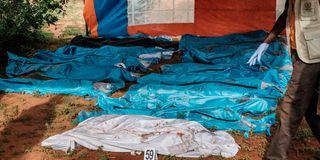
The Shakahola massacre is a tragedy that stands as a stark reminder of the perils of unregulated religious extremism in a country like Kenya, which continues to experience the growth of evangelical churches.
It has been exactly one year and nine months since the discovery of mass graves in the expansive Shakahola forest, Kilifi County, yet hundreds of families are still grappling with unanswered questions, seeking closure for their missing loved ones.
Roseline Asena is among the many families who have yet to know the whereabouts of their loved ones who migrated with their children to the forest.
“My brother’s five children have not been found. Each time we go to confirm at the morgue, we are told the DNA samples provided have not matched any of those profiled,” says Ms Asena.
Her brother, Kevin Sudi Asena, and his wife, Miriam Joyce Otembo, are jointly charged with doomsday preacher and suspected cult leader Paul Mackenzie over the death of more than 429 members of the Good News International church.
The five children are aged 16, 14, 11, three, and one.
Ms Asena states that the family has not received any communication from the government regarding the steps taken to locate the missing persons.
Loved ones
“We don’t know what the silence signifies. We heard they were planning to bury the deceased in a mass grave in the forest, but we don’t know if that has been done without our involvement. This process of searching for loved ones has been costly,” she says.
Another family, who wished to remain anonymous, is facing the same struggle.
Their sister joined Mackenzie’s church in 2020 after being influenced by the summons she followed through Times Television. They have not seen her since.
“Our continued visits to the morgue, hoping to find our sister’s body, have yielded no answers. It has been a painful wait. It is better to bury your loved one, knowing they are dead. Burying your loved ones helps you heal from the pain rather than being kept waiting in the dark,” the woman said.
Negative DNA results
Another family that also lost two brothers has also continued to tirelessly seek answers from the government about their whereabouts.
One commonality among those who have lost loved ones and are still missing is that they do not want to discuss the issue.
“I have their contacts; we are in a WhatsApp group, but none wants to discuss their missing or deceased loved ones or the Shakahola story. These individuals will follow silently with the government without wanting their identities exposed to the public,” says Ms Asena.
The families’ struggles have been worsened by the costs associated with travel to Shakahola, adding financial strain to their emotional burden.
“It has been expensive. But the government seems to be doing nothing to help us,” she says.
Many families, including that of Ms Asena's, have faced the heartbreak of receiving negative DNA results, extinguishing fleeting hopes of closure.
“You provide your DNA, but when you visit the morgue, you are told your missing person is not among those who have been positively identified, and the wait continues,” she adds.
The aftermath of this deadly massacre, linked to Mackenzie’s church and indoctrination, has left a grim legacy of unresolved deaths, unaccounted bodies, and a cumbersome identification process, revealing systemic failings in governance and crisis management.
As of now, 455 deaths have been documented in connection with the Shakahola massacre. This figure includes bodies exhumed from shallow graves in the forest, victims found beneath trees, and those who died while in hospitals, along the way or in custody.
However, only 53 of these bodies have been identified through DNA testing and physical identification, and merely 32 have been released to their families for burial.
Another 17 identified bodies are awaiting release.
Adding to the despair is the lack of accurate data on the number of people still missing.
While the Kenya National Commission on Human Rights (KNCHR) estimates that over 600 individuals remain unaccounted for, the absence of precise police records has compounded the uncertainty.
According to the commission, fewer than 10 percent of the Shakahola victims have been released to their families, leaving the majority of relatives in distress.
KNCHR has painted a grim picture of the identification process, noting that it has been marred by resource challenges.
The commission has censured the government chemist, the agency responsible for DNA matching, for its inability to expedite testing mainly due to funding shortages.
The commission has accused the government of failing to prioritise the crisis, lamenting that preserving Shakahola bodies instead of releasing them to their respective families is even more costly.
“We know that preserving these bodies is even more expensive, hence the need to allocate resources to conclude the process and provide families with relief,” KNCHR stated in a press release in November.
National Coroners Service Act
The commission has called for the operationalisation of the National Coroners Service Act, 2017, which it believes would have simplified the investigation process into the Shakahola deaths.
According to KNCHR, implementing this legislation could have facilitated more transparent and efficient inquiries, ensuring accountability and justice for the victims.
While the right to freedom of religion and belief is enshrined in Article 32 of the Kenyan Constitution, KNCHR has emphasised that this freedom is not absolute.
“It can and must be limited when public safety, health, morals, or the fundamental freedoms of others are at risk,” KNCHR said.
The court trying Mackenzie and his 94 accomplices has been informed that many of the Shakahola victims were coerced into starvation and subjected to abuse under the pretence of spiritual devotion.
Mackenzie and his co-accused are currently facing numerous criminal accusations in relation to the death of 429 people believed to be his believers.
They include 191 murder charges and another 238 manslaughter offences.
In addition to manslaughter and murder charges, Mackenzie and his group are also facing the offence of engaging in organised criminal activity, promoting extreme belief systems for the purpose of facilitating ideologically based violence to wit fasting to death by advancing religious change, radicalization and facilitating the commission of a terrorist act.
They are also facing several charges, including torture and cruelty against children and violation of the Basic Education Act.
They are alleged to have committed all these offences in Shakahola forest on unknown dates between January 2021 and September 2023. They had denied all these accusations.
The Shakahola incident has prompted the government to consider creating legislation to regulate churches and prevent religious extremism.
The Presidential Taskforce, established by President William Ruto to review the legal and regulatory framework governing religious organisations, proposed a series of measures to combat pious extremism.
The task force has recommended the enactment of statutes for religious organisations, the establishment of a Religious Affairs Commission, and the adoption of a hybrid regulatory model that combines self-regulation with government oversight.
However, some of these recommendations have been perceived by certain religious leaders as a government scheme to suppress freedom of worship and religion.

